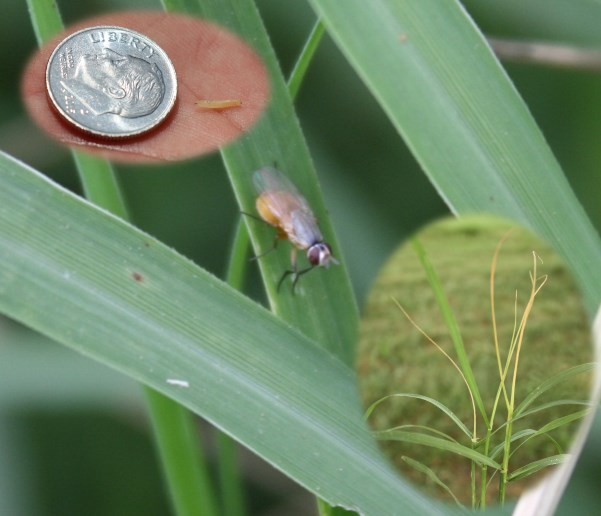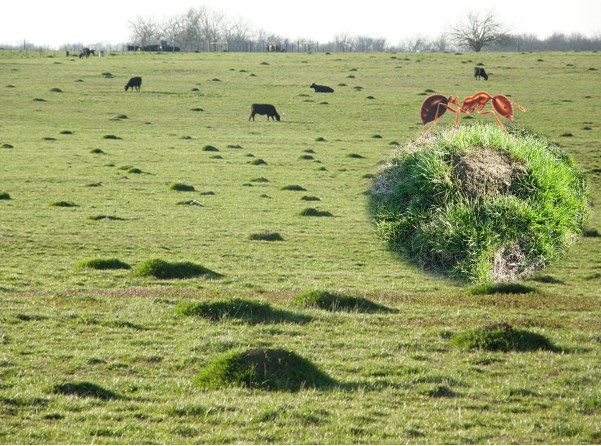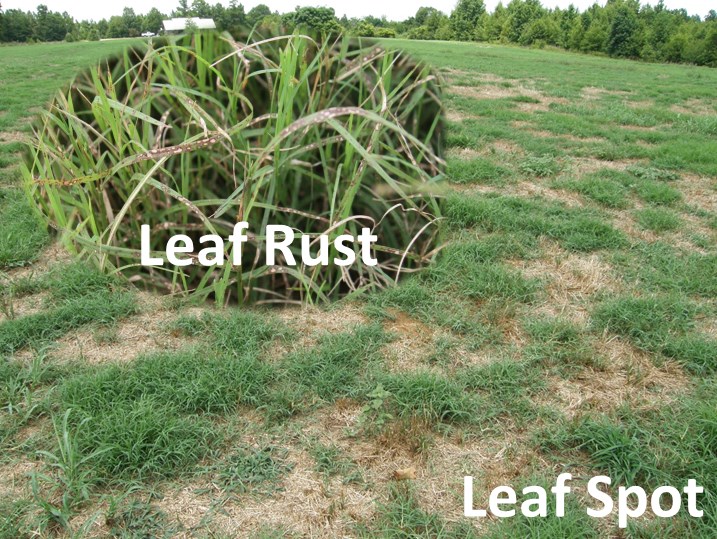Bermudagrass Pest Management
In Mississippi, bermudagrass hay fields are subject to attack by different diseases and insects and some of them can cause significant economic losses in biomass production and quality when the reach a high threshold and not properly controlled. Some of the most common pest are armyworms, bermudagrass stem maggot, fire ants, leaf rust and leaf spot disease.
Armyworms (Spodoptera frugiperda) – Armyworms can be very damaging to bermudagrass hay fields in matter of days if not controlled very quickly. During the summer armyworms remain in the caterpillar stage for approxi-mately 10 to 14 days and they do 80 to 90% of their feed-ing process in the last two to four days of their life cycle. During a threat of armyworms, forage and livestock pro-ducers should scout their hay fields every couple of days and be ready to spray. Spraying a hay field is recom-mended when there is an exceeding population density of three caterpillars per square area that are one-half inch in length. There are different insecticides that can be used for controlling armyworms. See Mississippi State Exten-sion Publication 2717, Fall Armyworms in Hay Fields and Pastures for more information and treatment recommen-dation.

Bermudagrass Stem Maggot (Antherigona reversura) – Bermudagrass Stem Maggot (BSG) is a non-native pest of bermudagrass hay fields that have been documented in Mississippi in 2009, Georgia in 2010 and since then had spread to hay fields across the southern US. Stem mag-got populations are usually low in the spring and increase as the growing season progresses. BSG is a pest in which adult flies lay eggs in the upper leaves of the bermu-dagrass stems. Once the white larve emerge, it bores in-side the tips of the bermudagrass shoot and feed down to the first internode thus killing the shoot tip and the emerg-ing leaves. A heavy infestation can create a bronze to frost appearance across the field due to the large number of dead bermudagrass shoot tips. Due to heavy infesta-tion, yield losses have been estimated from 20 to 50%. It has been indicated that the larvae cannot controlled once they bored into the stem since there are not systemic in-secticides labeled for forage production. In this case, the best approach is controlling the flies before they lay eggs on the shoot tips. If the flies have cause considerable damage of the tips, then the best approach will be to cut the hay and control the fly population in the next cutting cycle. It is recommended to harvest the field, remove the bales, and spray 5 to 7 days after harvest by using a low rate of the pyrethroid insecticides that are labeled for armyworm control such as Mustang Max (zeta cypermetrin), Baythroid (cyfluthrin), and Karate Z (lamda cyhalothrin). A second application 5 to 7 days later may be necessary. See University of Georgia Extension and Mississippi State Extension Publications for more information related to BSG.

Imported Fire Ants (Solenopsis sp.) – Fire ants can be found in almost every hay field across with the state with mount colonies ranging from 50 to 200 mounts per acre. Fire ants are omnivores, meaning that they eat both plant and animals to satisfy their nutritional needs. Although they have small impact in yield production, they can impact harvest by mounts damaging hay equipment. There are two types of imported fire ants in Mississippi, the black fire ant (Solenopsis richteri) and the red imported fire ant (Solenopsis invicta). These two species have interbred and produced a hybrid. Fire ants can be very territorial and lives in single-queen colonies that can establish up to 40 mounts per acre or they can live in multiple-queen colonies in which 200 to 300 mounts per care can be established. There are a few baits that are labeled for use in hay fields. Insecticide-based type baits will kill the queen, juvenile and mature fire ant works and control the colony for about 2 to 4 weeks. There are also insect growth regulator-based baits (IGR) that prevent new fire ants from developing and they could take 4 to 12 weeks to have complete control of the colony. The following three active ingredients are labeled for use in hay fields in Mississippi: methoprene, pyriproxyfen, and hydramethylnon. Be sure to read and follow the label directions and recommendations for haying restrictions. In Mississippi, shipment of hay outside the quarantine zone must be inspected, determined to be free of imported fire ants and accompanied by a permit, prior to movement. Contact a Mississippi Bureau of Plant Industry Inspector for regulations pertaining to the fire ant quarantine. See Mississippi State Extension Publication 2493, Control Fire Ants in Pastures, Hayfields, and Barnyards for more information and treatment recommendation.

Leaf Diseases – Leaf Spot Disease (Bipolaris cynodontis) and leaf rust (Puccinia cynodontis) typically appear in the early spring and summer when weather is warm (temperature between 80 and 95 ˚F) and high relative humidity. Because both diseases affect the leafy material of the plant, they can both decrease both hay yields and hay quality. Leaf spot can be identified by the formation of lesions on the leaves and the spots tend to concentrate in large numbers near the collar of the blade. The lesions are irregularly shaped and brownish to green to black in color. Severe infestation can cause the pathogen to attack crowns, stolons and rhizomes and infected plants may occur in irregular patches across the field. Affected fields may become brown and thin. On the other hand, leaf rust can look very similar to leaf spot to the naked eye. When look very closely under the microscope, leaf rust has more circular fruiting bodies in the inset. Lesions on the leaf or stem tissue are small with a red to orange color. At the present, there is no fungicides are labeled for use on forage grasses. Removing the infected leaves is the best way to reduce the amount of inoculum in a field and therefore the spread of the disease. Infected grass can be grazed off, cut for hay, cut and removed or the infected area may be burned if conditions allow such management.

Note: The information given here is for educational purposes only. References to commercial products, trade names, or suppliers are made with the understanding that no endorsement is implied and that no discrimination against other products or suppliers is intended. Generic products containing some of the active ingredients listed above are also available. Be sure to carefully read the label of any product you plan to use and follow all label restrictions carefully.
Upcoming Events
For upcoming forage related events visit: http://forages.pss.msstate.edu/events.html



